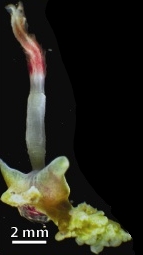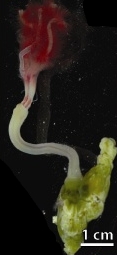Osedax
This article includes a list of general references, but it lacks sufficient corresponding inline citations. (December 2009) |
| Osedax | |
|---|---|

| |
| Osedax roseus | |
| Scientific classification | |
| Kingdom: | |
| Phylum: | |
| Class: | |
| Order: | |
| Family: | |
| Genus: | Osedax Rouse et al., 2004[1]
|
| Species | |
|
See text. | |
Osedax is a genus of deep-sea siboglinid polychaetes, commonly called boneworms, zombie worms, or bone-eating worms. Osedax is Latin for "bone-eating", the name alluding to how the worms bore into the bones of whale carcasses to reach enclosed lipids, on which they rely for sustenance.
Scientists from the Monterey Bay Aquarium Research Institute using the submarine ROV Tiburon first discovered the genus in Monterey Bay, California, in February 2002. The worms were found living on the bones of a decaying gray whale in the Monterey Canyon, at a depth of 2,893 m (9,491 ft).
Anatomy and physiology
Lacking stomach and mouth, Osedax rely on symbiotic species of bacteria to digest whale fat and oils and release nutrients that they can absorb. Osedax have colorful feathery plumes that act as gills and unusual root-like structures that absorb nutrients. The Osedax secrete acid (rather than rely on teeth) to bore into bone to access the nurients[2] . Between 50 and 100 microscopic dwarf males live inside a single female and never develop past the larval stage.
Reproduction
Female Osedax worms have been observed spawning both in the wild and in laboratory aquaria (Rouse et al., 2009). Osedax rubiplumus can spawn hundreds of oocytes at a time. The worms' endosymbiont, the bacteria Oceanospirillales, was not observed in the spawned oocytes, which suggests that they are acquired after the worms settle on the bones.[3] In the adult, the bacteria are localised in the root-like structures that grow into the whale bone.[4][5] This worm appears to be highly fecund and reproduces continuously. This may help explain why Osedax is such a diverse genus, despite the rarity of whale falls in the ocean.
Male Osedax are microscopic dwarfs that live as "harems" inside the lumen of the gelatinous tube that surrounds each female. An individual female can house hundreds of these males in her tube.[6][7]
History
Following its discovery in 2002, the genus was announced in Science in 2004.[1]
In late 2005, an experiment by Swedish marine biologists resulted in the discovery of a species of the worm in the North Sea off the west coast of Sweden. In the experiment, a minke whale carcass that had been washed ashore had been sunk to a depth of 120 m (390 ft) and monitored for several months. Biologists were surprised to find that, unlike the previous discoveries, the new species, colloquially known as "bone-eating snot flower" after its scientific name (Osedax mucofloris; a more accurate translation would be "slimeflower bone eater"), lived in very shallow waters compared to the previous discoveries.
In November 2009, researchers reported finding as many as 15 species of boneworms living in Monterey Bay on the California coast.[8]
Niche

The role of Osedax in the degradation of marine vertebrate remains is controversial. Some scientists think that Osedax is a specialist on whalebones while others think that it is more of a generalist. This controversy is due to a biogeographic paradox: despite the rarity and ephemeral nature of whale falls, Osedax has a broad biogeographic range and is surprisingly diverse. One hypothesis advanced to explain this paradox is that Osedax are able to colonize a variety of vertebrate remains besides whalebones. This hypothesis is supported by an experiment involving cow bones suspended above the sea floor. A variety of Osedax species successfully colonized these bones. Osedax have also been observed colonizing terrestrial mammal bones mixed in with galley waste from a surface vessel. Other scientists have countered this hypothesis by pointing out how the cow bone experiment does not match any natural habitat and also the low probability of terrestrial mammal bones arriving at the ocean floor in significant quantities. They also point out other cases of food falls in which the remains disappeared too swiftly for Osedax colonization and the lack of any observed colonization in similar cases. The true role of Osedax in the degradation of marine vertebrate remains is important to marine vertebrate taphonomy. Burrows closely similar to those made by Osedax species have been found in the bones of ancient marine birds, suggesting that the genus may once have had a wider range of foods.[9][10]
Species

See also
References
- ^ a b G. W. Rouse, S. K. Goffredi, and R. C. Vrijenhoek (2004). "Osedax: Bone-Eating Marine Worms with Dwarf Males". Science. 305 (5684): 668–671. doi:10.1126/science.1098650. PMID 15286372.
{{cite journal}}: CS1 maint: multiple names: authors list (link) - ^ . BBC News http://www.bbc.co.uk/nature/18594493.
{{cite web}}: Missing or empty|title=(help) - ^ G. W. Rouse, N. G. Wilson, S. K. Goffredi, S. B. Johnson, T. Smart, C. Widmer, C. M. Young, and R. C. Vrijenhoek (2009). "Spawning and development in Osedax boneworms (Siboglinidae, Annelida)". Marine Biology. 156 (3): 395–405. doi:10.1007/s00227-008-1091-z.
{{cite journal}}: CS1 maint: multiple names: authors list (link) - ^ Goffredi, S. K., Orphan, V. J., Rouse, G. W., Jahnke, L., Embaye, T., Turk, K., Lee, R. & Vrijenhoek, R. C. 2005 Evolutionary innovation: a bone-eating marine symbiosis. Environmental Microbiology 7, 1369-1378.
- ^ Piper, Ross (2007), Extraordinary Animals: An Encyclopedia of Curious and Unusual Animals, Greenwood Press.
- ^ G. W. Rouse, K. Worsaae, S. Johnson, W. J. Jones, and R. C. Vrijenhoek (2008). "Acquisition of dwarf male 'harems' by recently settled females of Osedax roseus n. sp. (Siboglinidae; Annelida)". Biological Bulletin 214: 67–82.
- ^ Vrijenhoek, R. C., Johnson, S. & Rouse, G. W. 2008 Bone-eating Osedax females and their "harems" of dwarf males are recruited from a common larval pool. Molecular Ecology 17, 4535-4544. doi:10.1111/j.1365-294X.2008.03937.x
- ^ Vrijenhoek, R.C., Johnson, S.B. & Rouse, G.W. 2009 A remarkable diversity of bone-eating worms (Osedax; Siboglinidae; Annelida). BMC Biology 7, 74 (13 pages). doi:10.1186/1741-7007-7-74
- ^ Bone-boring worm once had a taste for birds. Osedax worms might have had a more-rounded diet 30 million years ago. Matt Kaplan. Nature, 6 December 2010. doi:10.1038/news.2010.651 http://www.nature.com/news/2010/101206/full/news.2010.651.html
- ^ Steffen Kiel, Wolf-Achim Kahl and James L. Goedert. Osedax borings in fossil marine bird bones. Naturwissenschaften. The Science of Nature. Published online: 20 November 2010. doi:10.1007/s00114-010-0740-5 http://www.springerlink.com/content/6vpv015338513652/
Further reading
- Jones, W. J (22 February 2008). "Marine worms (genus Osedax) colonize cow bones". Proceedings of the Royal Society B: Biological Sciences. 275 (1633): 387–391. doi:10.1098/rspb.2007.1437.
{{cite journal}}: Unknown parameter|coauthors=ignored (|author=suggested) (help) - A. G. Glover, K. M. Kemp, C. R. Smith and T. G. Dahlgren (2008). "On the role of bone-eating worms in the degradation of marine vertebrate remains". Proceedings of the Royal Society B. 275 (1646): 1959–1961. doi:10.1098/rspb.2008.0177. PMC 2596369. PMID 18505721.
{{cite journal}}: CS1 maint: multiple names: authors list (link) - R. C. Vrijenhoek, P. Collins and C. L. Van Dover (2008). "Bone-eating marine worms: habitat specialists of generalists?". Proceedings of the Royal Society B. 275 (1646): 1963–1964. doi:10.1098/rspb.2008.0350.
External links
- Press release describing discovery of Osedax
- BBC website - link to story about discovery of Osedax worms in the North Sea
- A Motley Collection of Boneworms - Monterey Bay Aquarium Research Institute
